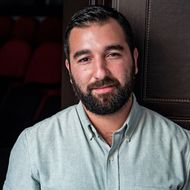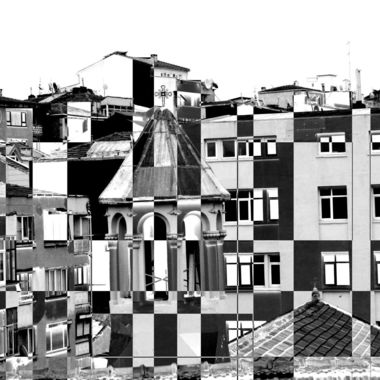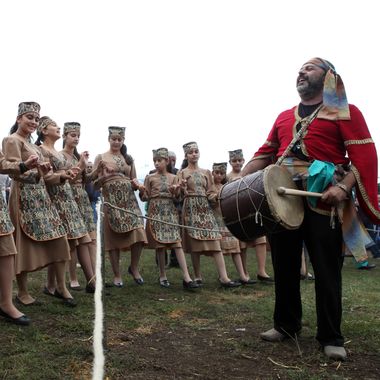Fri Jul 28 2017 · 11 min read
The “Discursive Turn” of Armenian Politics
The Challenges of Finding a Common Political Language

By Varak Ketsemanian

Maybe it is better to start with a disclaimer to avoid any misunderstandings:
This article is neither a criticism, nor an attack on any of the organizations mentioned. Moreover, it is not an attempt to depict the age old picture of the “West” vs “East/Russia” as it relates to the Armenian reality.
On June 16, 2017, “The Armenian Interest,” a recently founded think tank, launched its platform and presented it to a mixed audience of Russians and local Armenians including some state officials such as Artsrun Hovhanissyan, the spokesperson of the Ministry of Defense and current Prime Minister Karen Karapetyan’s father, among others. On the same night, Impact Hub Yerevan welcomed its guests, colleagues and friends (along with many expats and repats as well as representatives from the UN and the U.S. Embassy) to celebrate the first anniversary of its opening in Armenia. In the first case, Russian was the dominant language of the event, whereas English and Armenian dominated the latter. Why the comparison?
Maybe it is better to start with a disclaimer to avoid any misunderstandings: This article is neither a criticism, nor an attack on any of the organizations mentioned. Moreover, it is not an attempt to depict the age old picture of the “West” vs. “East/Russia” as it relates to the Armenian reality. Rather, I use these two examples as a window through which we can analyze some larger socio-political processes of the Armenian political arena, as well as a gateway to understand some of the challenges and shortcomings that still prevail in what we often name “Post-Soviet” Armenia. Although what “The Armenian Interest” purports to do as a research center varies considerably from the agenda of organizations such as Impact Hub Yerevan, AGBU, OneArmenia, Idea Foundation and similar ones, an observation with a comparative lens can lead to us to tackle some fundamental questions that remain unanswered in the changing dynamics of the 21st century.
In his latest analysis, “In Search of the Armenian Political Brand,” Areg Galstyan argues that historical and political circumstances have led to the formation of two overarching Armenian “brands” - recognition of the Armenian Genocide and the struggle for the independence of the Artsakh Republic. Galstyan then raises two important questions, namely “Who are we?” and “Where are we going?” contending that in the absence of a clear understanding and vision, the Armenian factor in world politics becomes only the object element of other actors’ interests. Finally, the author concludes that the Armenian world needs to go through a long political path to form a national brand.
Though an offspring of the Genocide narrative, currently there seems to be an attempt to create a new “national” brand of “Armenian Humanitarianism and Global Awakening” based on the philanthropic vision of Ruben Vardanyan, Noubar Afeyan, and Vartan Gregorian with the recently established Aurora Prize. Despite its success in attracting celebrities and some international attention to Armenia, the initiative remains incomprehensible for many, including this author.
Although Galstyan does a wonderful job in explicating the theoretical framework of his analysis and its relevance to the Armenian case, there is a missing link which the author refers to in the final sentence of the article, yet does not elaborate on (maybe he will do so in upcoming pieces), namely, the political culture of the Republic of Armenia. Engaging with the ideas that Galstyan has used, I argue that one of the reasons Armenians have failed to come up with a palatable “national brand” lies in the absence of common political premises (beyond the Genocide and Artsakh) upon which collaborative platforms may be created in the Diaspora, but more importantly, in the Republic of Armenia.
In other words, not only did 2016, a tumultuous year (April War and Sasna Dzrer), further polarize Armenian society, but after 25 years of independence, parties, organizations, and civil society in Armenia have failed to carve a common and a mutually intelligible political language out of the multiplicity of ideas and ideologies that permeate Armenian social, cultural and political spheres. As analyzed in a recent article “Beyond Nationalism: The Case for Engaged Patriotism on the Eve of the 100th Anniversary of Statehood” by Raffi Ardhaldjian and this author, liberal or populist nationalism was not, and cannot simply be the answer to Armenia’s statehood challenges, as 25 years of inefficient governance has shown.
As blunt as this may seem, the Armenian political arena, but mostly Diasporan pan-Armenian organizations who found their way into independent Armenia after 1991, are still tainted by the scars of the Cold War, as mutual sentiments of distrust, disbelief and apprehension dominate the political discourse.
The urgent need to dig deeper in the midst of the intellectual crisis as Armenian ethno-national identity continues to adapt, raises the question of effective and strategic collaboration among Diasporic and Pan-Armenian organizations that transcend generic Genocide recognition campaigns, as well as activism towards congressional resolutions in favor of the independence of Artsakh.
Although these two “Pan-Armenian” issues, if we can label them as such, may be among the very few exceptions for which there seems to be a “unanimous” agreement (to the outer world), a deeper look reveals the divergence of visions, beliefs, and strategies that various groups (political, social and cultural) of the nation have vis-à-vis the solutions to these two “overarching causes.” In this respect, although the Genocide and the question of Artsakh are marketed as “national brands,” a critical deconstruction of the discourse that each one of these groups puts forth disclose some facets that are far from being “national” [համազգային]. The clash of the “Diaspora” with the “Armenian State” during the Armeno-Turkish protocols of 2009, and the different plans of the Armenian political spectrum for the settlement of the Artsakh conflict, are just two vivid examples of the lack of such a common political language.
Going back to the two examples referred to in the beginning of this article, there exists several civic, professional, and political groups in Armenia that are often engaged in various humanitarian, cultural, economic and other types of projects, yet which fail to cooperate around key structural issues that may lead to the greater good. A quick look at the Armenian socio-political landscape would affirm the Armenian saying “Amen Meguh ir Eshuh guh Kusheh (Everyone rides his own donkey).” As blunt as this may seem, the Armenian political arena, but mostly Diasporan pan-Armenian organizations who found their way into independent Armenia after 1991, are still tainted by the scars of the Cold War, as mutual sentiments of distrust, disbelief and apprehension dominate the political discourse. It is in this context that one should look at the very rare instances where collaborative endeavors are undertaken by AGBU and the Armenian Revolutionary Federation (ARF) [the two largest pan-Armenian organizations], to name only a few.

The political terminology that dominated the Cold War decades is still perpetuated by many of these organizations, as stereotypes are often used and recreated to “describe” particular sets of people (mostly young) from the wide ranging spectrum of Armenian politics. In this respect, words such as “the Dashnaks” (Դաշնակները) are often uttered to invoke particular derogatory characteristics or mindsets such as “aggressive nationalism,” “blind patriotism,” “populism” etc. On the other hand, however, the latter group often describes initiatives by the AGBU and the Idea Foundation as “elitist” or simply “bourgeois”; in addition to the discursive power that such terms carry with them as “legacies” of the Cold War era, and that many have failed to overcome or simply understand, such terminology indirectly and often directly polarizes the different actors of the Armenian political arena. Whereas the “Dashnaks” are often seen as diehard nationalists ready to fight foreign enemies, they are “opposed” by the ostensibly non-political AGBU as being too adventurous.
Whereas neoliberal models of development adopted by the AGBU, OneArmenia, Idea Foundation and others such as “entrepreneurship,” “global networking,” “identity engagement,” “community building,” “Western education” and “cultural preservation” become the new jargon among an emerging though small group of professionals in post-Soviet Armenia, calls and programs for constitutional changes, institutional reforms and structural revamping addressed by parties (opposition and coalitions alike) of the “Armenian Establishment” (including the ARF and others) remain unheeded. Thus, it is not surprising that neither civil society, whose activists consist mostly of people affiliated with the former organizations, nor Armenian political parties have seriously approached each other for a better assessment of the situation. Moreover, whereas civil society activists see the “Armenian Establishment” (often rightfully so) as a cluster of corrupt, self-serving and paternalistic officials and institutions, the latter respond by frequent and brutal repressions, or simply accusations of being “Western” agents.
Unfortunately this discourse has found its way among young repats and expats who constitute a considerable proportion of the professional staff of many of these non-profit organizations. Seldom do we see professionals affiliated with one “group” (whichever that may be) partake in civic, educational, political, cultural or any other project initiated by the other. Although this may be inaccurate for some local or insignificant endeavors, a look at the overall socio-political configuration in the Republic of Armenia reveals the undeniable existence of ossified “sets” of people (whether ideological, cultural, or social). This in turn hampers all efforts of mutual participation and identification, obstructing attempts for collaborative platforms.
We have come to an age where different approaches to particular issues such as education quality, civic engagement, etc. necessitate cognizance and acknowledgement, and not concealment under the general rubric of “Armenians.” The real challenge consists in finding common premises for strategic cooperation and effective collaboration in spite of the social, cultural, and political differences that we all exhibit.
Whereas neoliberal models of development adopted by the AGBU, OneArmenia, Idea Foundation and others such as “entrepreneurship,” “global networking,” “identity engagement,” “community building,” “Western education” and “cultural preservation” become the new jargon among an emerging though small group of professionals in Post-soviet Armenia, calls and programs for constitutional changes, institutional reforms and structural revamping addressed by parties (opposition and coalitions alike) of the “Armenian Establishment” (including the ARF and others) remain unheeded. Thus, it is not surprising that neither civil society, whose activists consist mostly of people affiliated with the former organizations, nor Armenian political parties have seriously approached each other for a better assessment of the situation. Moreover, whereas civil society activists see the “Armenian Establishment” (often rightfully so) as a cluster of corrupt, self-serving and paternalistic officials and institutions, the latter respond by frequent and brutal repressions, or simply accusations of being “Western” agents.
The incidents during the two-week “Sasna Dzrer” stalemate in July 2016 or the reaction “Citizen Observer” initiative are still fresh in our minds and demand no further explanation. Whether we can consider the abovementioned ideas as modern day values, and make them fit into the overall state apparatus through ministries, municipalities etc. is an issue that awaits its proper appraisal. Concepts such as “community building,” “global humanity,” and “civic engagement” with neo-liberal undertones remain not only vague for most sections of the population, but can be easily deemed as “foreign,” “inorganic,” or “alienating” if they are not truly and properly enshrined through the overall state apparatus, and encoded into government practices.
The Idea Foundation’s calls for “Global Armenians” published on the October 28, 2016, though bearing the potential for “unprecedented spirit of partnership and coordination among all Armenian organizations and individuals” has not produced such a discursive turn, as the 23 signatories did not include any “organizations” per se. In this respect, not only did the concept of “Global Armenians” remain ambiguous, but the initiative included individuals closer to AGBU circles and policies, excluding the ARF as “global” (to use the same jargon) and indirectly omitting countries such as Lebanon and Iran (where the ARF is the dominant force). Looking at the main points raised in this declaration such as “An opportunity for the Armenian world to pivot toward a future of prosperity, to transform the post-Soviet Armenian Republic into a vibrant, modern, secure, peaceful and progressive homeland for a global nation;” “An opportunity for Armenians not only to have survived Genocide, but to reconstitute and thrive;” “An opportunity for Armenia to secure long-lasting social and economic improvement, for our citizens today as well as for our children and the future of our global nation,” one can easily see the similarities or even the exact wording in platforms prepared by almost any Armenian political party on the eve of elections. In this respect, the word “global” falls nothing short of being a trendy, yet vague jargon. Whether the “nation” can truly go “global” without the true incorporation of key players is yet another issue that awaits its proper response. Finally, whether “Global Armenians” (whoever they may be)] are really incentivized to “help the fatherland” without an Armenia-centric [Հայաստանակեդրոն/ Hayasdanagetron] mindset, and in the absence of a politicized youth, is another rarely discussed aspect of such calls. Sometimes it is worth reminding ourselves that labeling initiatives such as “Pan-Armenian” (Համահայկական) or “Global” (Համաշխարհային; Համընդհանուր) does not necessarily make them such.
Not only does the improvement of the situation require flexibility by all, but more importantly a “discursive turn” by political parties that control access to the political arena and considerable resources. Taking the particular case of the 127-year- old Armenian Revolutionary Federation, one of the major players of Pan-Armenian politics, the party’s Supreme Council should refrain from making vague statements around ambiguous concepts such as “united Armenians” [Miyatsyal Hayutyun] (see the ARF Bureau’s declaration on July 18, 2017). The time has come to debunk myths such as these, when the sole “cause” that perhaps unites all Armenians (though not their vision for the future as explained above) is the recognition of the Genocide.
We have come to an age where different approaches to particular issues such as education quality, civic engagement, etc. necessitate cognizance and acknowledgement, and not concealment under the general rubric of “Armenians.” The real challenge consists in finding common premises for strategic cooperation and effective collaboration in spite of the social, cultural, and political differences that we all exhibit. As Hrant Markarian, the chairman of ARF Bureau recently declared, the party is facing problems when it comes to the question of reaching out to larger sections of society. Armenian political parties need to clearly understand that they can benefit from civil society, the professional expertise of many of the abovementioned organizations, as much as the latter’s need to fill the gap that exists among them and the political apparatus (ministries, municipalities, parties etc.) per se.
by the same author
The Intellectual Crisis of the Armenian Reality
By Varak Ketsemanian
Varak Ketsemanian presents a critical analysis of Sona B. Dadoyan’s work, “2015, The Armenian Condition in Hindsight and Foresight: A Discourse,” a timely and critical piece of scholarship that sheds light on the intellectual crisis of the 21st century Armenian reality.
Armenia: Anatomy of a State
By Varak Ketsemanian
After more than 25 years of independence, what can the role of the Armenian Republic be in shaping a discourse that would speak of Armenia in terms of a “homeland” and a genuine state?
As much as this may sound utopian, it requires a real platform upon which steps can be taken and alternative opinions shaped and accepted. In this respect, the Ministry of Diaspora has failed to become an epicenter around which a new kind of political conversation could have started, one that would have formulated the new discursive tools essential for bridging the many, yet disconnected initiatives.
Where do we start engaging in this discourse?
Despite the many missed opportunities, the upcoming sixth “Armenia-Diaspora Conference” scheduled for the September 19-20, 2017 in Yerevan is yet another opportunity to launch such a platform and turn it into a venue for a serious exchange of ideas, rather than a eulogy of the traditional institutions of the Armenian reality. This can only be done by integrating new voices, concerns, and debates into the overall picture, while finding ways to cement the different approaches, methods and visions. Among others, Armenian public intellectuals bear this heavy burden of pressuring the Armenian Government and relevant bodies to instigate such a discourse, and overcome this “intellectual” stalemate.
Tackling concrete issues such as the quality and material of education in Armenia, civic engagement, and cultural branding, this conference can and should pave the way to two fundamental questions that each participant group needs to address, namely “What can you give to a particular sector?” and “Is there a way to synchronize it with other efforts?” It is only through the harmonization of different ideas, coordinated by a strong epicenter, that the Armenian reality can achieve “the discursive turn” and formulate a common political language that is a pre-condition for carving a new “national brand” that Galstyan marked in his essay.




